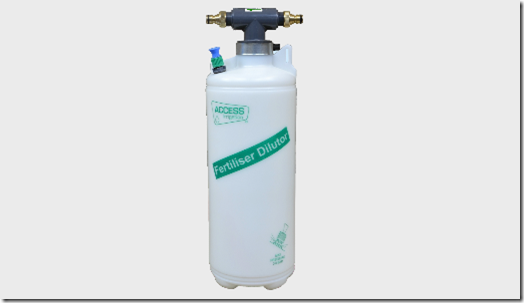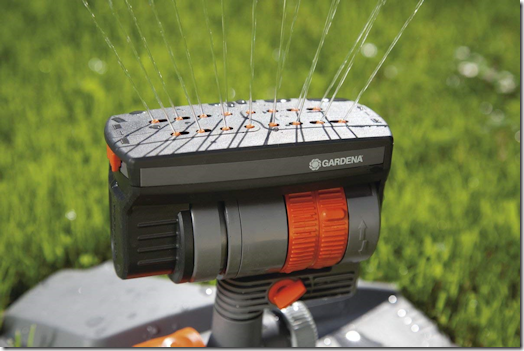
One of the most popular posts on the blog is the one about Silver Birch Trees shedding leaves in the middle of summer as a result of nutrient deficiency in the soil. The remedy involves applying fertilizer and watering it in so the trees can get at it.
In 2018, though, another cause of premature yellowing has surfaced. The prolonged hot weather has stressed many trees, and the remedy for that is deep watering.
Ever since I found the solution to the nutrient problem I had toyed with the idea of semi-automating the fertilizer/watering process by combining the two and applying it via a sprinkler system. Indeed, I toyed to the extent that I bought a cheap Venturi mixer – which should have worked, but didn’t. I concluded that my water pressure was not sufficient to provide the necessary lift in the Venturi, because I just couldn’t get it to suck anything up. So I gave up on the idea for a year or two until 2018, when watering became such an issue in its own right.
I started Googling and many things came up, but they were all on a small scale – watering plants in greenhouses or by drip-feeders. But there was an American dilutor which apparently did exactly what I was after. You put your fertilizer in the mixer container, connected it to a tap, connected the other side to a hosepipe, and let it do the mixing before sending it down to your sprinkler or spray nozzle. The problem was availability in the UK. It came in various sizes, and the only one carried by any UK-based seller had a capacity of one pint (damned American units), which is no bloody use at all except for window boxes or greenhouses. The next size up was only available from American suppliers, so apart from the $100+ price tag, there was also the $100+ shipping fee – not to mention whatever UK Customs & Excise (who have become very sharp of late) slapped on it when it came into the country.
I was just steeling myself to order the American product, but while I was searching for the best price I accidentally came across the Access Irrigation Static Dilutor. It hadn’t come up on any of my previous searches over the last three years, and even when it did this time it hardly stood out until I followed the link and read the specification sheet and user manual. As an aside, whoever designed the Access Irrigation website decided to use images of text for product titles instead of just plain old searchable text. As a result, Google isn’t indexing them and normal search terms like “inline fertilizer dispenser” or “fertilizer dispenser using sprinkler” don’t stand a chance.
Access Irrigation were very helpful with my pre-order questions, so I went ahead an ordered it. It came next day.
 I’ve also recently bought a new sprinkler – a Gardena ZoomMaxx. Depending on water pressure it can water over a range of between 3m and 18m, or an area between 9m² and 216m² in an almost circular pattern (though the pattern is adjustable). In my case, with a water flow rate of 7L per minute (which is classed as “low pressure”), it was able to cover an area of around 80-90m² – which is about 5 times what my old bar sprinkler could manage.
I’ve also recently bought a new sprinkler – a Gardena ZoomMaxx. Depending on water pressure it can water over a range of between 3m and 18m, or an area between 9m² and 216m² in an almost circular pattern (though the pattern is adjustable). In my case, with a water flow rate of 7L per minute (which is classed as “low pressure”), it was able to cover an area of around 80-90m² – which is about 5 times what my old bar sprinkler could manage.
The Access Dilutor consists of a thick plastic bottle which can hold about 9L of liquid. A screw-fit head assembly consists of a Venturi unit with a choice of Hozelock or GEKA fittings (Hozelock fitted as standard, but both types supplied).
For anyone who is interested, a Venturi is so-called because of the Venturi Effect. This is where a fluid flowing through a constriction in a tube creates a pressure drop, and this can be used for various effects. I became familiar with it when I was still at school, because we used small Venturi devices connected to laboratory taps to produce a partial vacuum when filtering liquids using conical flasks. In the case of the Dilutor, water flowing from your tap goes via the Venturi and down to the sprinkler head, and the pressure drop created inside the Venturi is used to pull liquid fertilizer from the bottle and into the main water flow. There is a bit more to the device than that, though, because as the fertilizer is removed, it is replaced by clean water to keep the bottle completely full. Since the fertilizer solution is more dense than water, this clean water sits on top, so you have a distinct border between fertilizer and water. Access Irrigation says you should use food dye if your fertilizer is colourless so that you can see when it is all used up. In my case, my mixture contains chelated iron, so it is almost black. Incidentally, this is why they call it the “static” dilutor, because you mustn’t move it when you’re using it, otherwise the divided liquids get all mixed up.
Until I tried it I was sceptical, but it really does work. The Dilutor is supplied with a range of nozzles which fit on the end of the dip-tube that carries the fertilizer. This allows you to control how quickly the fertilizer is used up. In my case, since I wanted to irrigate for an hour at each of several locations, and since my water flow was 7L/min – or 420L/hour – I used the light blue nozzle corresponding to this volume of water (edit: I have since changed to the grey nozzle, which uses the fertiliser more quickly, my logic being that I want to get the fertiliser on the lawn, then make sure it is watered in properly). I was doing my first run in the dark – literally – and using a torch the border between the black solution and clean water was dramatic. It was all used up in slightly more than one hour.
Previously, and as I have pointed out in my article about summer leaf drop, I was dissolving solid ericaceous fertilizer in water (which takes a couple of hours), and using this as a concentrate in five watering cans-full each liberally spread over 10-20m² (about half an hour overall), then watered in using a bar sprinkler for about half an hour in each of five locations to get the coverage. Overall, it was maybe 8 hours involving frequent interventions by me.
Now, using a liquid version of the same ericaceous fertilizer, I can make up a full batch in the Dilutor in about three minutes, and just set the sprinkler running for an hour. Then, I make another batch, move the sprinkler, and repeat. It only takes a couple of hours now to get the same coverage – and I’m doing a lot more irrigation because of the heat stress problem this year.
What are the different nozzle colours?
I don’t want to state what the colours are (though I did mention a couple, above), because Access Irrigation might change them at some stage, and then whatever I’ve written would be wrong (one of mine was not quite the colour the instructions said, anyway). However, four of these are supplied, and they give you a 10:1, 25:1, 50:1, or 100:1 dilution ratio.
Obviously, the 100:1 jet will be the smallest, and the 10:1 jet will be the widest. So you can work it out from there just by looking at them. The lowest ratio jet (widest) will use up whatever you’re spreading quicker than the highest ratio (narrowest) jet.
To be honest, unless you’re doing something really strange, the best thing is not to overthink these numbers. In my case, for example, I use a jet which empties my feed in about 45-60 minutes. That’s long enough to get an even spread and deliver an effective watering over about 100m².